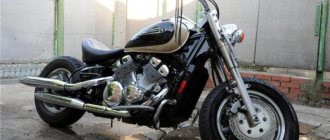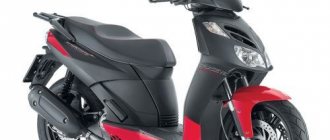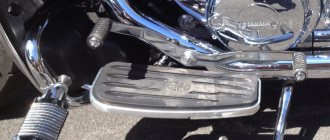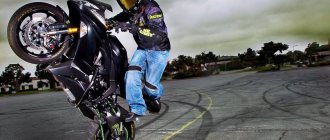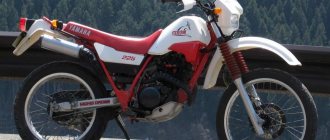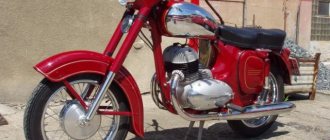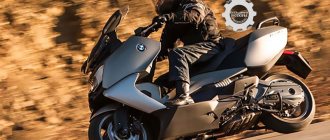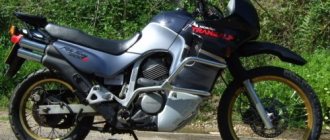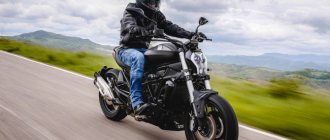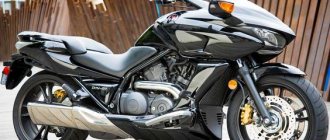| Yamaha XVZ1300A Royal Star (1996-2001) | Yamaha XVZ1300AT Royal Star Tour Classic (1996-2000) | Yamaha XVZ1300LT Royal Star Tour Deluxe (1997-2001) |
Yamaha XVZ1300A Royal Star cruiser model
was first introduced in 1996 and was intended for sales in Japan, Europe and the USA. The main feature of the motorcycle was the use of a V-shaped 4-cylinder engine, migrated from the touring version of the Venture Royale. Thanks to this engine layout, the vibration level was low (compared to a 2-cylinder layout), the motorcycle received a unique exhaust sound, and, importantly, it was possible to obtain impressive power and torque for this class - 75 hp. and almost 112 Nm. At the same time, the engine remained heavily derated, reaching maximum performance starting from 3500 rpm.
Main modifications of Yamaha XVZ1300A Royal Star
:
- Yamaha XVZ1300A Royal Star
- regular version. - Yamaha XVZ1300AT Royal Star Tour Classic
- touring version with a different saddle, windshield, panniers and backrest for the passenger. - Yamaha XVZ1300LT Royal Star Tour Deluxe
- touring version. It features a 2-in-1 exhaust system, plastic saddlebags, rear crash bars and passenger platforms.
In 1998, the Yamaha XVZ1300A Royal Star model finally left the Japanese market, but continued production for Europe and the USA. 2001 was the last year of the model’s existence on the market, after which it finally left the assembly line. However, the XVZ1300 concept continued to exist until 2013 inclusive in the form of the luxury tourer XVZ1300TF Royal Star Venture (1999-2013) and the new generation modification of the Royal Star Tour Deluxe (XVZ1300LT) - Yamaha XVZ1300CT Royal Star Tour Deluxe (2005-2009).
The main competitors of the Yamaha XVZ1300A Royal Star in the class:
- Honda GL1500 Valkyrie
Specifications
Technical characteristics of Yamaha XVZ1300A Royal Star:
| Model | Yamaha XVZ1300A Royal Star |
| Motorcycle type | cruiser |
| Year of issue | 1996-2001 |
| Frame | steel tubular |
| engine's type | 4-cylinder, 4-stroke, V-shaped |
| Working volume | 1294 cm³ |
| Bore/Stroke | 79.0 x 66.0 mm |
| Compression ratio | 10.0:1 |
| Cooling | liquid |
| Number of valves per cylinder | DOHC, 4 valves per cylinder |
| Fuel supply system | carburetor, 4x Mikuni BDS28 |
| Ignition type | transistor TCI |
| Maximum power | 75.0 hp (55.1 kW) at 5000 rpm |
| Maximum torque | 112.0 Nm (11.4 kgf*m) at 3500 rpm |
| Clutch | Multi-disc in oil bath, hydraulic drive |
| Transmission | 5-speed |
| type of drive | cardan |
| Front tire size | 150/80-16M/C (71H) |
| Rear tire size | 150/90-15M/C (74H) |
| Front brakes | 2 discs, 298 mm, 4-piston calipers |
| Rear brakes | 1 disc, 320 mm, 4-piston caliper |
| Front suspension | 41 mm telescopic fork, travel - 140 mm |
| Rear suspension | pendulum with monoshock absorber (adjustable preload), stroke - 95 mm |
| Motorcycle length | 2480 mm – Royal Star 2485 mm – Royal Star Tour Classic + LT |
| Motorcycle width | 910 mm |
| Motorcycle height | 1160 mm – Royal Star 1475 mm – Royal Star Tour Classic + LT |
| Wheelbase | 1695 mm |
| Seat height | 715 mm – Royal Star 725 mm – Royal Star Tour Classic + LT |
| Minimum ground clearance (clearance) | 150 mm |
| Acceleration 0-100 km/h (0-60 mph) | 5.98 sec[1] |
| Maximum speed | 162 km/h[2] |
| Gas tank capacity | 18.0 l (including reserve - 3.5 l) |
| Motorcycle weight (curb) | 330 kg – Royal Star 354 kg – Royal Star Tour Classic + LT |
Route around the country
The famous Taj Mahal / photo by the author
We chose the road Delhi - Agra - Delhi - Goa.
In Agra they wanted to see the Taj Mahal , and then they were going to relax on the beaches for a couple of weeks and stop at:
- Jaipur - the pink city
- Udaipur - the white city,
- Mumbai is a crazy city.
We made stops in other small towns, but there is nothing special to write about them: city, hotel, shower, bed, morning, motorcycle.
The quality of roads in India turned out to be better than we thought. As long as you're driving on the highway, everything is fine. But the further you go from civilization and central roads, the more problems there are.
On the highway there are often buses with passengers on the roof, so they escape the heat. People drive in India mainly based on sounds rather than rear-view mirrors; many even roll them up so as not to interfere. Even if there are mirrors, don’t let this be misleading, locals look at themselves in them, and not at the roadway. That's why there are a lot of sounds on the road. In big cities it is so noisy that it is impossible to talk on the street.
Why such a difficult route?
Roads in India / photo by the author
My husband and I came to India for the first time in 2021, to Goa. We immediately fell in love with this country and dreamed of traveling to other states, looking at the people who live there, seeing their daily life.
The people there are very friendly and love to chat. Usually people only remember from English: “Hello! Which country? But judging by the pleasure it gives them to say this, you can’t help but rejoice in communicating with a pleasant, cheerful person.
The Taj Mahal was a dream for both of us. I really wanted to go there, although it was inconvenient - I had to go in the opposite direction, which added 400 extra km. When we were planning the trip, it seemed that such a distance meant nothing in terms of the beauty of this architectural monument.
Reviews
Reviews about Yamaha XVZ1300A Royal Star:
Expand Collapse
Yamaha XVZ1300 Royal Star. I have a Royal cruiser, although not a Venture, I’m very happy with it. If desired, it rolls quite vigorously, the steering wheel does not tilt during maneuvers, and it is not at all difficult to control. I’m selling mine because I want to buy a Royal Tour Deluxe, which is more suited for long-distance driving. Yes, and the classic has 74 strength, and the Ventura and Deluxe have 97! And the Ventura has air suspension.
We have Royal Star Venture serviced. This summer, he and his wife took a tour of the center and north of Russia and enjoyed the trip.
Yamaha XVZ1300 Royal Star. It's an awesome vehicle, I speak as the owner.
The front brakes are weak. It's better not to burn out the clutch. When buying, be sure to check the compression, although they say that the engine is indestructible, but I still had to change the piston rings - it’s expensive. It’s a lot of luck, the rear passengers say it’s a bit harsh, but the driver is located in the middle relative to the wheel axles, so he doesn’t give a damn. It holds the road rooted to the spot at any speed, thanks to the low center of gravity, since the very heavy engine sits low. And accordingly, for its weight, there is good (sometimes better, but is not considered here) controllability; while driving, the weight is not felt at all. When choosing, it is advisable to pay attention to the seats, those in the standard configuration (smooth) are very hard on the butt, everyone complains about them, they are needed from the Tour De Luxe.
Yamaha XVZ1300 Royal Star. Mine has 75 horses…….I’m head over heels happy, acceleration is 5 seconds to 100, cruising speed is 120-130. what else do you need? And what doesn’t work is, as I understand it, said by those who don’t know how to use the gearbox on this motorcycle (they are demanding about the correct choice of gears in various modes).
It may be a little heavy, but I don’t notice, since I’m not small myself, and its center of gravity is low; in traffic jams, despite the huge panniers, I got the hang of riding a bicycle.
What is there to talk about... A motorcycle WORTH its name
Differences between a Prostov piano and a Ventura piano
1) tank, the tidy has been moved from the tank to the face, the piano has large chimes on the tank and the Ventura has an old-school LCD, the tank is 4 liters larger due to the fact that the Ventura has 2 air vents on the outside and the piano has it under the tank
2) the engine of the Ventura is more vigorous, but it makes a slightly unusual whistling sound; the piano produces it in a smaller speed range and is practically absent, and it seemed to me that the exhaust of the piano sounds more pleasant than that of the Ventura, but this is subjective
3) the piano's shock absorber is horizontal at the bottom and the Ventura's is vertical in the center
4) Ventura has all sorts of tourist horns in stock, like a lot of chumadanov music, but all this can also be installed on the piano, but Ventura’s generator provides 50W more electricity, which in principle is nonsense.
Latest posts Popular The most interesting motorcycle news
you are reading the most popular news you are reading all the news you are reading the latest news read the most popular read all the news read the latest news
“Givry Works” is the first thread leading us to the origins of this glorious history. This was the name of the needle production, which at the end of the 19th century was organized by a certain George Townsend in a small English village, in which everyone was engaged in the manufacture of needles and fishing equipment. But the decision to become a competitor to his neighbors did not bring George the expected success. Then he began to think more broadly, and his entrepreneurial instinct led him to buy a bicycle in 1880.
It's amazing how one household decision can become the beginning of a grandiose development of something big and important. Something that will become part of the worldview for several generations of the entire country. But then George Townsend could not have known that in the middle of the next century the production of his native motorcycles with a classic design would stop in England, but in India it would not only continue its successful development, but would also become the raison d’être for many, many.
So far, the ancestor of the modern Enfield was a rather uncomfortable bicycle, made of wood and shod with iron. Today it would probably become popular among hipsters, but George understood that for his contemporaries he needed to invent something comfortable and less rigid. So he made a spring seat and launched its production. Development was in full swing, and the supply of components for bicycles was supplemented by the production of bicycles themselves - in just 3 years the company produced about 20 models - for that time this was quite a lot.
But things went well for George only until 1890. Problems with finances and falling sales made us think about third-party investments. All this led to the fact that in 1892 Townsend was no longer the head of the company, which now bore the name “The Eadie Manufacturing Company Limite” in honor of its new owner Albert Eady. One of the divisions began to produce new bicycles called Enfield. As a result, they gained such popularity that a separate, independent brand began to grow from this, and soon the Enfield motorcycle was developed, which for the first time sounded like Royal Enfield.
Thus, a legend was born.
In 1914, wartime began. The release of the sought-after Royal Enfield sidecar motorcycles, which could be mounted with machine guns, was intended to help the British and Allied armies.
The most famous four-actor Royal Enfield Bullet 350 today began its journey in 1947. Such a motorcycle became in demand after the war and throughout the world. The Indian company Madras Motors became interested in Bullitts for the army of their country and won the tender in 1949. From this year, Royal Enfield begins a new round of development and history. Indians first begin to simply assemble the Royal Enfield Bullet 350 from components that were sent from England, and then the production of Bullets in India takes on full scale when, from the mid-50s, it was decided that the police and army would be equipped with durable and durable Bullets.
Since the very beginning of the 60s, Enfield Indian has been roaming the American landscape, participating in races and championships, having resounding success until 1964. At this time, the popular Continental GT model was created, which became a cult motorcycle for the partying youth who wandered to coffee shops. Practical and stylish, the exemplary cafe racer was equipped with a sports tank and windshield and could easily outrun any scooter.
In 1962, England stopped producing Bullitts; in 1970, the Royal Enfield brand itself left, leaving behind only pleasant memories and...
Of course, grandiose production in India.
From there, Indian Enfields have not gone away, except that they are sold abroad, and very actively, and in 1995 the Indians completely acquired the rights to the brand and its full name. Thus, the plant became completely independent with its own special Indian atmosphere. England, Germany, the USA and Japan became regular customers of Royal Enfield when the time came for retro and vintage in the late 80s, and the eastern manufacturers of Bullitt hooked the audience, placing a marketing emphasis on the fact that the design of motorcycles had remained virtually unchanged since 1955. year
Thanks to the small size of diesel engines, the motorcycle has economical fuel consumption of 1.5 liters per 100 kilometers. True, the single-cylinder engine is capable of producing only 6.5 horsepower. Indians don't consider their motorcycles to be perfect. And although until very recently the car continued to develop and change in some ways, these changes occurred very smoothly - people never ceased to feel their worthy place, which they occupied in the long history of Royal Enfield.
In 1993, Royal Enfield Motors Limited began developing two new models.
In parallel with the release of the old Bullitt, in 1998, a new model Machismo A350 with touring glass began to be produced, equipped with a modernized 350 cc engine, an aluminum cylinder and an electronic ignition system, as well as the best cruiser of 2002 according to the British motorcycle community - Thunderbird 350. The new Royal Enfield Himalayan was recently released, and the manufacturers assure that it will appeal to those who love the classic '47 Bullitt.
Since 2005, the company has set a course for the European modernization of the motorcycle, moving the gearbox from right to left. And if for Europeans these four-act machines are perceived as stylish, trendy retro motorcycles that can become a cool basis for custom, scramblers and cafe racers, then for the Indians themselves they have become not just a motorcycle culture, but a real native creature.
That is why, when a new engine was developed in 2006, equipped with Japanese injection and a starter, the craftsmen who devoted their whole lives to this British brand and subordinated it to themselves, while also subordinating it themselves, began to feel that they were passing away along with an entire era to the past.
mobile connection
The guy who sold us the motorcycle in Delhi made us two SIM cards. The connection is called Airtel - mobile Internet, limited, like everywhere else. There are almost no unlimited tariffs for mobile Internet. It catches well, but sometimes there was no connection on the road; maps downloaded in advance helped.
If you are traveling alone, you can connect right at the airport. At the exit there is a kiosk where they sell SIM cards and change money. I don’t recommend doing the latter, since the exchange rate in the city is better.
Public transport
For transport in India, we used taxis, metro and tuk-tuk - inexpensive motorcycle taxi.
We went to Delhi by metro. The price depends on the number of stations (10-50 rubles). I won’t even indicate taxi prices, since they depend on what mood the driver is in and whether he saw the light in your eyes. You need to bargain until he agrees to reduce the price by half and then leave dissatisfied. Then you will find out the real cost of the trip. There's nothing you can do, it's a custom.
Where we spent the night
Hawa Mahal in Jaipur / photo by the author
We lived in inexpensive hotels, once even in a hostel called Howste l (a place in a room 400 rubles) in Jaipur. It was so neat and cheap, everything was new and beautiful, the sheets were crisp with cleanliness and freshness, which is something you don’t usually get from the staff in other places in India.
Hotels along the road cost 800-1000 rubles. per night.
Everywhere you had to bargain desperately. When locals see tourists, they think that dollars are pouring out of their pockets.
Where and how we ate
During the trip, we ate both in restaurants and cafes, and took street food. Never got poisoned.
Considering how many spices, including pepper, ginger and others, they put in their dishes, all food is disinfected. The spiciest dish I tried was in Jaipur. My husband and I cried pepper-red tears and for a long time tried to breathe fresh air and drink cold water.
By the way, milk is a good remedy for a fire in the mouth .
At the end of the meal in the cafe, along with the check, they give you a saucer with sugar and anise seeds. At first we didn’t understand why this was necessary, but then, after watching how the locals famously put them in their mouths after eating, we did the same. Anise seeds extinguish fires from spices and freshen breath.
